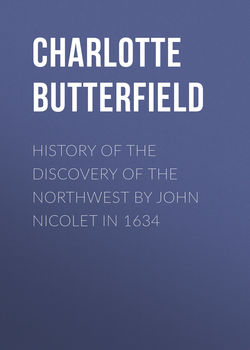Читать книгу History of the Discovery of the Northwest by John Nicolet in 1634 - Charlotte Butterfield - Страница 2
INTRODUCTION.
PRE-HISTORIC MAN IN THE NORTHWEST – THE RED RACE – FIRST DISCOVERIES IN NEW FRANCE
ОглавлениеOf the existence, in what are now the States of Ohio, Indiana, Illinois, Michigan, and Wisconsin, at a remote period, of a race superior in intelligence to the red men who inhabited this region when first seen by a European, there are indubitable evidences. Who were these ancient occupiers of the territory just mentioned – of its prairies and woodlands, hills and valleys? There are no traditions of their power, of their labor, or of their wisdom – no record of their having lived, except in rapidly-decaying relics. They left no descendants to recount their daring deeds. All that remain of them – the so-called Mound-Builders – are mouldering skeletons. All that are to be seen of their handicraft are perishing earth-works and rude implements. These sum up the "types and shadows" of the pre-historic age.
There is nothing to connect "the dark backward and abysm" of mound-building times with those of the red race of the Northwest; and all that is known of the latter dating earlier than their first discovery, is exceedingly dim and shadowy. Upon the extended area bounded by Lake Superior on the north, Lake Michigan on the east, wide-spreading prairies on the south, and the Mississippi river on the west, there met and mingled two distinct Indian families – Algonquins and Dakotas. Concerning the various tribes of these families, nothing of importance could be gleaned by the earliest explorers; at least, very little has been preserved. Tradition, it is true, pointed to the Algonquins as having, at some remote period, migrated from the east; and this has been confirmed by a study of their language. It indicated, also, that the Dakotas, at a time far beyond the memory of the most aged, came from the west or southwest – fighting their way as they came; that one of their tribes1 once dwelt upon the shores of a sea; but when and for what purpose they left their home none could relate.
The residue of the Northwest was the dwelling-place of Algonquins alone. In reality, therefore, "the territory northwest of the river Ohio" has no veritable history ante-dating the period of its first discovery by civilized man. Portions of the country had been heard of, it is true, but only through vague reports of savages. There were no accounts at all, besides these, of the extensive region of the upper lakes or of the valley of the Upper Mississippi; while nothing whatever was known of the Ohio or of parts adjacent.
The first of the discoveries in the New World after that of Columbus, in 1492, having an immediate bearing upon this narrative, was that of John Cabot, in 1497. On the third of July, of that year, he saw what is now believed to have been the coast of Labrador. After sailing a short distance south, he probably discovered the island of Newfoundland. In 1498, his son, Sebastian, explored the continent from Labrador to Virginia, and possibly as far south as Florida. Gaspar Cortereal, in 1500, reached the shore seen by John Cabot, and explored it several hundred miles. He was followed, in 1524, by John Verrazzano, who discovered the North American coast in, probably, the latitude of what is now Wilmington, North Carolina. He continued his exploration to the northward as far as Newfoundland. To the region visited by him, he gave the name of New France. The attention of the reader is now directed to some of the most important events, in the country thus named, which followed, for a period of a hundred and ten years, the voyage of Verrazzano.
1
Ancestors of the present Winnebagoes.
